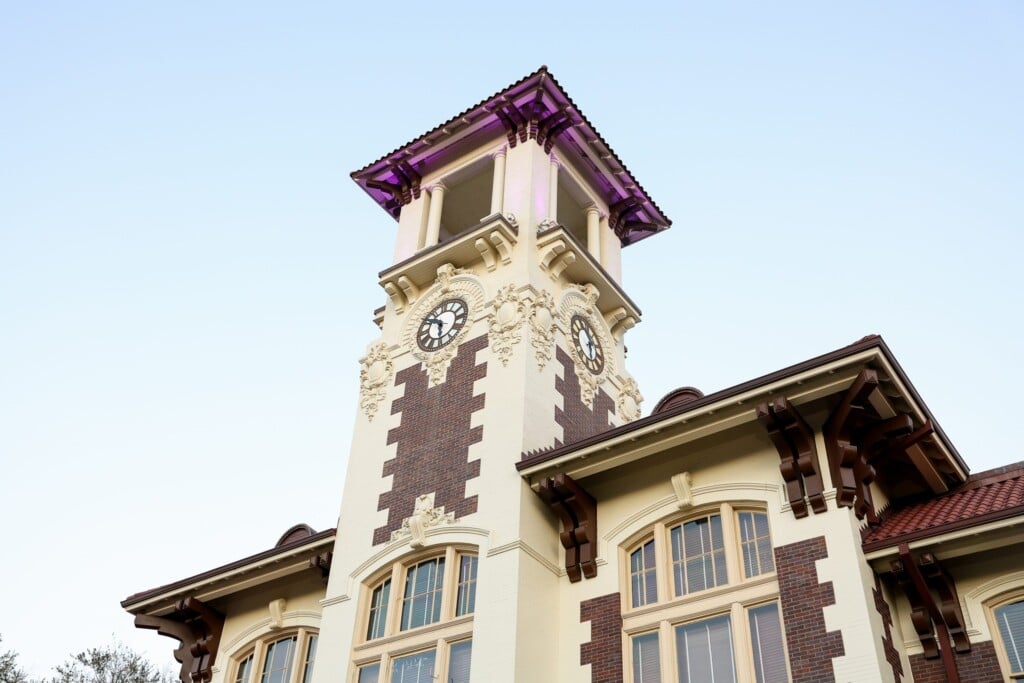Hoop Net Fishing
A Fishing technique that is an ancient, near-biblical endeavor

At Butte La Rose, the Atchafalaya River makes a sharp turn east-northeast in yet another bid to lure the Mississippi into its path. The river here runs black. It’s slender, smooth as paper. On a warm morning in late December, thick fog swirls around the dock while Rusty Kimble starts his boat engine.
“That’s the Atchafalaya,” he says. In the predawn quiet, it sounds almost like a question, but that can’t be right. Rusty knows this river. His surprise, even after 25 years of fishing here, marks him as a native of the river 75 miles to the north, in Simmesport, where he began fishing commercially — on his own and in his own boat — at age 14, in 1983. There, the river churns muddy, its temperament more Hyde than Jekyll. The Old River Control Structure, a feat of engineering that prevents the Atchafalaya and Mississippi from merging and keeps south Louisiana inhabitable, looms 20 miles to the northeast, causing the river to fluctuate more there than elsewhere. That led Rusty to move his work south. Throughout the fall, winter and spring, he drives from Simmesport, setting out from Butte La Rose to raise 42 hoop nets. The round trip leads him through 50 miles in one sliver of an area larger than the Florida Everglades.

“People in Louisiana don’t know what’s out here,” Kimble says of the Atchafalaya Basin. For some, the name alone conjures mystery, an aura at the back of the Louisiana psyche. For others, it’s there on the map, a vast yet unknowable expanse that begins near Simmesport and stretches southward 150 miles to the Gulf of Mexico. It’s the largest floodplain swamp in North America, a breadth of bottomland hardwoods, swamps, bayous and backwater lakes
that covers nearly one million acres. You could hide the entire state of Rhode Island inside, and few would think to look. Through this region cuts the Atchafalaya River, North America’s fifth largest by discharge. Combine the Atchafalaya and Mississippi river basins, and you would have, after the Amazon and Congo, the third largest river basin in the world.
Rusty rattles off those and other facts before pausing to note the obvious. To truly see North America’s largest wetland and river swamp, you need a boat. Getting that opportunity means to fall back through time to a place where men such as Rusty Kimble fish in a way that summons scripture. “Put out into the deep, and let down your nets for a catch,” Christ advises Simon in the Gospel of Luke.

Once each week, Kimble sets out to do exactly that. He and his cousin Carson Kimble raise nets much as fishermen have done for millennia: by hand. The grueling labor ahead explains why Carson steps into the boat and immediately lies down. On these trips, the Kimbles haul in an average of 4,000 lbs. of fish. The boat’s two wells will hold another 1,000 lbs. Today, because the river has been low, Rusty expects to bring in 3,000 lbs. “If you have great expectations, you’re easily let down,” he says. “The secret of life for being happy is to be grateful for every day on this side of the water.” At that, Carson shuts his eyes, and Rusty backs away from the dock. “All right,” he says. “There’s no guarantee we’ll make it back.”
Around the first bend, two herons — one blue, the other white — hopscotch across treetops. Rusty shakes his head. “Cajuns are superstitious,” he says. “They believe what their grandpa told them.” In his youth, fishing with his uncle, Rusty heard tales about how heron behavior foreshadowed the workday. To see them perched in trees means there will be few fish. To see them along the riverbank means the fishing gods are on your side.
For ten minutes, Rusty navigates through a veil of fog. Trial and error have taught him where to set his nets, which he began making when he was 9 years old. He weaves a net through nine hoops, each six feet in diameter. Once he sets them in the water, his full hoop nets stretch to 30 feet. Hedging his bets, and maybe because of another superstition, he always places two side by side. “To be a good fisherman, you don’t need to know where the fish are,” he says, now edging along the eastern bank. “You need to know where they’re going to be.” He then accordions his hands, explaining how the current pushes on the nets like a sail on a boat. “The fish get out of the current to rest. You got to look at it like the wind. You would get out of the wind. That’s how they end up in the nets.”

Rusty Kimble and Henderson-based commercial fisherman Jeremy Hayes make their hoop nets at home. Kimble constructs his hoops from PVC Pipe, Hayes from fiberglass. After weaving the net through the hoop, Hayes dips the entire construction into a vat of tar. Freshly tarred nets, some stretching to 30 feet, often hang like bats in his back yard. He and Kimble work constantly to mend and clean their nets so they “fish better,” as Hayes says.
As the boat slows, Carson rises and positions himself on the starboard side. From a stump, he grabs the black line he tied the week before, and within seconds, he’s pulling, easy at first, now harder, leaning backwards. After 15 seconds, the hoop net surfaces like a submarine. Rusty moves beside him. When two fishermen stand side by side, a net boat lays low to the water. “You’re not lifting the fish into the boat,” Rusty says. “You’re rolling the nets over the side.” The flare, a raised, angled section at the bow, deflects waves. This proves particularly handy with large hauls, something at the forefront of any fisherman’s imagination. At the front of Rusty’s: buffalo fish. He makes more money selling his hauls for crawfish bait rather than for human consumption. “They say Louisiana is a farm-based community. It’s crawfish-based. They got to have that bait.”
From one set of nets, Rusty steers toward another. After several stops, he realizes he’s set today’s expectations too low. Fish jump inside each net like dollar bills in a manic money blowing booth, and he and Carson raise the hoops high for the fish to funnel onto the deck. The work pauses only when Rusty needs to mend a net, typically after an alligator gar has thrashed around in attempted escape. Aboard the rocking boat, his netting needle weaves — dances is more precise — 20 seconds here, 30 there. “Makes a surgeon jealous with envy,” he says. And then it’s on to the next nets.

“Water flowing in from the north creates cool and optimal conditions on the Atchafalaya,” Rusty Kimble says. He typically sets nets in 8-27 feet of water. On occasion, he moves them from one spot to another, noting that fish always want to “bed up” around structures near banks. “They like the drop off,” he says. Hoop net fishermen perpetually raise nets, haul their load onto the boat, then release the nets back into the current.
For four hours, without break, he and Carson work like figures from the Old Testament. They toss fish inside the two wells, only stopping when Rusty needs to mend another net. “Work done by a master technician at your local shop,” he says. Putting the netting needle away, he gazes upon the river as though pleasantly surprised to find himself here on a Monday morning. The fog has lifted. There’s no other boat in sight.
“Thoreau went to Walden Pond,” he says. “I hunt. I fish. I do what I like. Look around. Ain’t nobody else out here with us today. I’m gonna do this ’til I die. Just like ‘Junior’ Edwards. Junior’s a real swamp dog. He’s old school.”
“I ain’t no Rusty Kimble,” says William “Junior” Edwards the next morning on Little Tensas Bayou. “I don’t fool with superstitions. I fish.” Fog unfurls like stretched cotton as William steers north to raise the first of his 42 hoop nets, each placed on its own. “My family always fished that way,” he says. “It’s more efficient.”

Like his old friend Rusty Kimble, he raises nets once a week and sells to a market that turns his fish into crawfish bait. “You don’t have an argument,” he says, noting the higher market value. This wasn’t always the case. He and Rusty recall a golden age of hoop net fishing in Louisiana, but that was more than 30 years ago. Since then, the cost of everything about their work — from the trucks that haul their boats to the gas that propels them — has risen while the market price for their product has stagnated. Rusty believes that in 20 years, this work in Louisiana will vanish. Sometimes, he cuts that prediction in half.
The speed at which William pilots his boat —and the fact that it takes nearly twice as long to raise 42 nets when they aren’t hung in pairs —means that he’s less prone to make predictions. Throughout the morning, his brother Wesley and Te Boy Domingue raise net after net, grabbing the hoops and lifting them high. Buffalo, along with an occasional catfish, tumble onto the deck. Their movements are efficient, methodical, but William wants them to work faster.

“I’m gonna get you a box of Wheaties,” he says after they pause, grimacing. And once again, the net rises grunt by grunt, a single haul that William estimates at 300 lbs. After four hours, the boat’s two wells — each capable of holding 2,500 lbs. — threaten to overflow. But William still wants more. “It’s hard to find good help,” he says, and Wesley shrugs his shoulders in what seems like a routine that began half a century before.
At the next stop, the net isn’t where they hung it last week. Wesley drags a hook across the riverbed, searching for the line. After two passes, he pulls it up, and in unison all three identify the culprit: “Beaver.” William sits with his netting needle to mend the damage, at last giving Wesley and Te Boy time to rest.
Then they speed to the next nets, another raised, another lowered, and inside of each, fish flutter and thrash. Five hours into the trip, water cascades over Junior.
“Cold water down the front of my shirt,” he says.
“I had to wake you up,” says Wesley.
And once again, they move on, the waterways in the Basin like a maze inside this ruler-flat empire nearly the size of the Grand Canyon. It thrives in plain sight, unknown, unknowable to many, a lifeblood for others, and on this day, nothing about this way of work seems precarious.
From the dock, Junior drives 10 miles south to sell the haul in Bayou Pigeon. The scales tally 4,946 lbs. The day before, Rusty Kimble’s haul weighed in at 3,647 lbs. of buffalo and 187 lbs. of catfish. In another week, they’ll both be back on the water, and the Basin will be here, this vast watery world where they pursue their ancient work.


